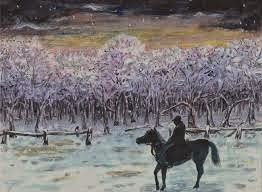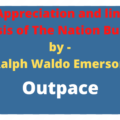ABOUT THE POET
·
Robert Frost
·
Full name –
Robert Lee Frost
·
Born – 26 March,
1874, San Francisco, California, USA.
·
Died – January,
29, 1963, Boston, USA.
·
Notable works –
i)
After Apple
picking
ii)
Dedication
iii)
Hannibal
iv)
Mending wall.
v)
A way out etc.
·
Awards –
i)
Won Pulitzer
Prize in 1924, 1931, 1937, and 1943.
ABOUT STOPPING BY WOODS ON A SNOWY EVENING
“Stopping By Woods on a snowy Evening” is one of the
celebrated poems by Robert Frost. The poem is all about a lonely horse rider who paused for a bit during his travel to behold snow falling in the woods. He is much moved and elated by the scenic beauty of the snow-covered wood.
His journey on horseback is a journey of a human symbolically. One pauses at some point of life to retrospect and then moves forward to the destination.
He ends the poem with the realisation that there may be loveliness of the view but life does not mean this. He has provided to keep and must take his journey on before gets his ultimate rest.
BACKGROUND OF STOPPING BY WOODS ON A SNOWY EVENING
It was written in one of the days in the month of June of
1922 at his house in Shaftsbury, Vermont. The inspiration of the poem was during the composition of another poem “New Hampshire”.
He worked full night working on “New Hampshire”. It was morning then. He went out to behold sunrise. At that very moment, he decided to compose “Stopping By the Woods On a Snowy
Evening.”
STRUCTURE OF STOPPING BY WOODS ON A SNOWY EVENING
“Stopping By Woods on a Snowy Evening” is a poem written
of 16 lines equally divided into 4 stanzas with 4 lines each. It is written in Iambic tetrameter. The poem is written in Rubaiyat poetry form (A poetry which is written in quatrains on four lines).
This poem carries typical rhyme scheme which is termed as “terza rima (Even named as third rhyme”, it is rhyming verse stanza which consists of interlocking rhyme scheme. It was first used by Italian poet Dante Alighieri).
The poem is of the typical rhyme scheme of AABA – BBCB – CCDC – DDDD. Besides, the poem contains poetic devices like Alliteration, imagery, personification, Anaphora repetition etc.
A TRUE REFLECTION OF NATURE
“Stopping By woods on snowy Evening” is based on the
stupendous beauty and repose of nature. Dark winter evening transports us to a world of tranquillity. Snowy flakes, frozen lakes create a living image of scenic beauty.
The poet cleverly brings a comparison between the civilized and to that of the natural one. Here nature is presented true, beautiful and soothing one whereas the civilized world is mean for pain, suffering struggle etc.
SYMBOLICAL REPRESENTATION OF LIFE
When we go through the last two lines of the poem the
the poet makes us think the poem bears a different tone the straight forward meaning of the concluding couplet makes us face that the traveller will take the rest of the journey and them take rest.
But this even symbolises is man’s journey in life. One goes on facing hindrances and restraints in life and then goes for the eternal abode.
STANZA WISE EXPLANATION
STANZA -1
The speaker acquaints us with the fact that he is
somewhere in the woods. He is near the woods when he says that, “these woods” and he seems to be confident about the owner of the woods. The owner of the woods lives in the village.
The poet here consciously brings a parallel comparison between the natural world to that of civilized one. He is a bit happy that the owner stays in the village and he will not be questioned for intruding here, he has no chance to see him stopping hers.
The word ‘stopping’ makes us sure that the traveller has stopped here already. The last line shows how the poet is fanatic about scenic beauty. He enjoys the scene of wood covered with white snow.
Poetic Devices in use :-
·
Alliteration –
“whose woods’, “His house”
·
Inversion –
“whose woods these are I think I know”.
STANZA -2
The opening line of the second stanza clears the fact that he
is not alone, he is on horseback. Even the opening line shows that the horse has got the sense of perceptibility and the horse knows the fact very clear that it is unusual to stop at a place.
The opening line even shows that the author also knows how the horse may think. It is queer only because the speaker stopped at a place where there is no farmhouse near.
We are very clear about the position of the poet. He stands between the frozen lake and the woods. Then the poet goes on describing how dark the evening was. He concludes the evening to be the darkest evening of the year. (Maybe 22nd December)
Poetic Devices in use:-
·
Antithesis –
Between the woods and frozen lake
STANZA – 3
At the outset of the third stanza, we find the horse to react. The horse shakes his harness bell only to assume if the owner mistook. As the traveller and horse have an understanding of what may happen.
The horse knows that it is unusual to stop at a place without a farmhouse. Now the poet makes us extra conscious about his being alone. He acquaints us that except the bell sound there had been only the sound of the swift blowing of the wind and snowfall.
Poetic Devices in use:
I) Alliteration – “ his harness”.
STANZA – 4
Here the poet goes on sharing how he liked the wood. He
tells us that the wood is a lovely one. At the same time, it is deep and dark which reflects its uncanny and unknown part.
Now the poet takes a turn. He says that he cannot stop here and behold the snowy wood. Rather he needs to move on as he has some promises to keep. He makes us feel that he belonged to the civilized society and needs to accomplish his responsibility facing all hindrances.
The concluding couplet is a bit intriguing as they are repeated. Firstly in a straightforward way, we can conclude that he will travel miles and there he would get rest.
In another way, it reflects the deeper philosophy of life. One has to move on years of one’s life facing all odds and then he will get a chance for the eternal sleep.
Poetic Devices in use: –
i) Repetition –
‘And miles to go before a sleep”








Why is the ownership of the woods and the absense of the owner so important? Could they represent another man'alluring wife? The lifelong promise only released by death then are his wedding vows. The woods offre comfort from the frozen lake his marriage has become. The harness bells are the man's conscience telling him to turn away.